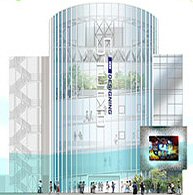Kyocera to Outsource Production
Kyocera Corp. will from the end of the month start outsourcing production of mobile phones sold in the US market to Singaporean firm Flextronics International Ltd., the Nihon Keizai Shimbun reported, without identifying its sources. Earlier this year, Kyocera moved production of its phone handsets to Mexico from the US in a bid to improve profitability. But with the group handset business still suffering a 14.9 bn yen loss for the year ended 31 March, Kyocera decided to go one step further and move production to an outside company, the financial daily said.


 KDDI has opened an Alpha Pup playland for its mobile universe right in the heart of Tokyo fashion central — Harajuku. Five floors of interactive phones and games,
KDDI has opened an Alpha Pup playland for its mobile universe right in the heart of Tokyo fashion central — Harajuku. Five floors of interactive phones and games,  This free-for-all program takes you to KDDI’s recent launch event at the Imperial hotel announcing the carrier’s three new WIN handsets, all now making use of Macromedia Flash lite. You’ll get a close-up of these phones in action plus tips on the new 3G flat-rate price plan coming in August. We also highlight NTT DoCoMo’s N900iL dual-mode 802.11b/W-CDMA handset based on the FOMA N900i which, unfortunately, has been transformed into the de facto proprietary, intranet-only “Passage Duple”
This free-for-all program takes you to KDDI’s recent launch event at the Imperial hotel announcing the carrier’s three new WIN handsets, all now making use of Macromedia Flash lite. You’ll get a close-up of these phones in action plus tips on the new 3G flat-rate price plan coming in August. We also highlight NTT DoCoMo’s N900iL dual-mode 802.11b/W-CDMA handset based on the FOMA N900i which, unfortunately, has been transformed into the de facto proprietary, intranet-only “Passage Duple”